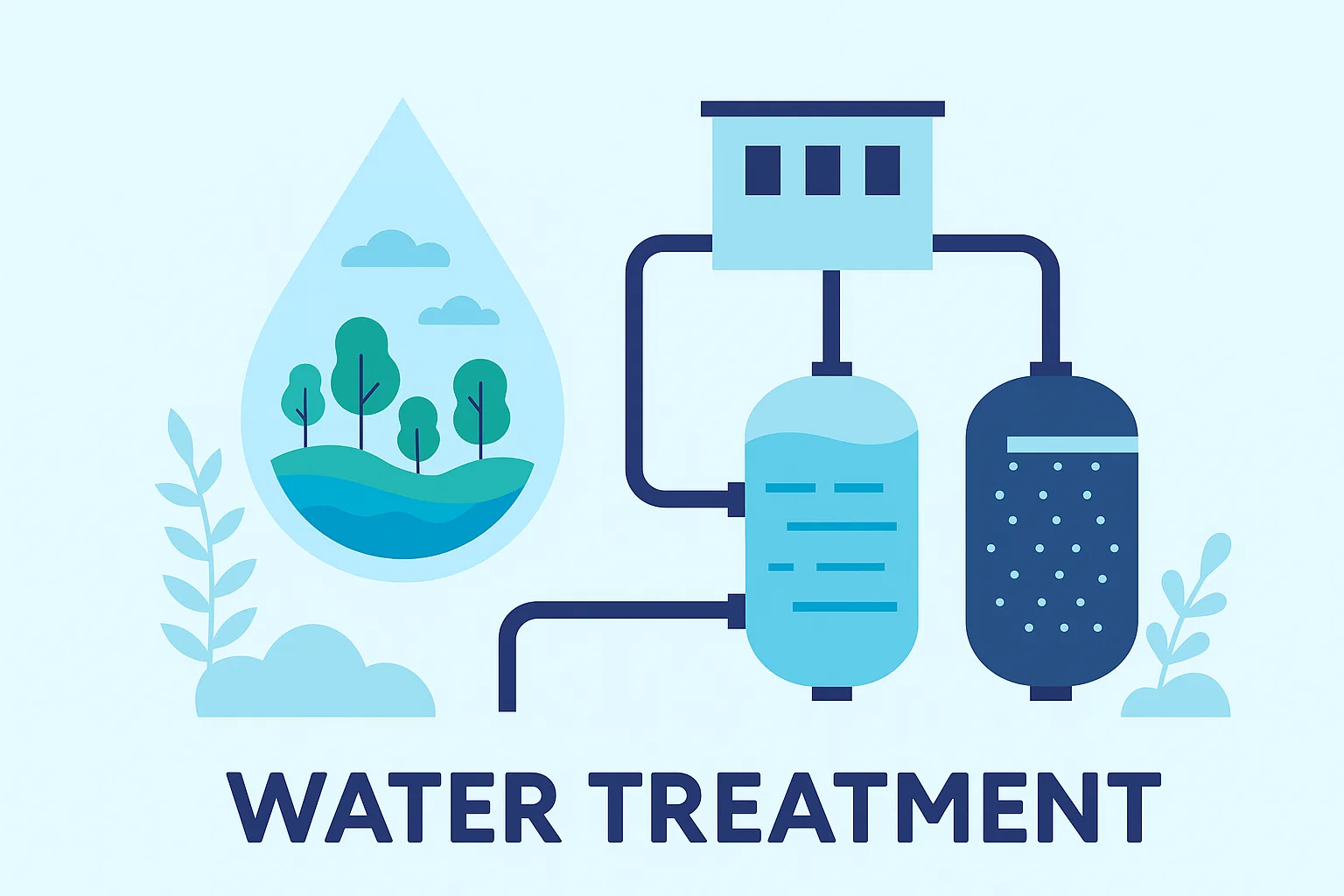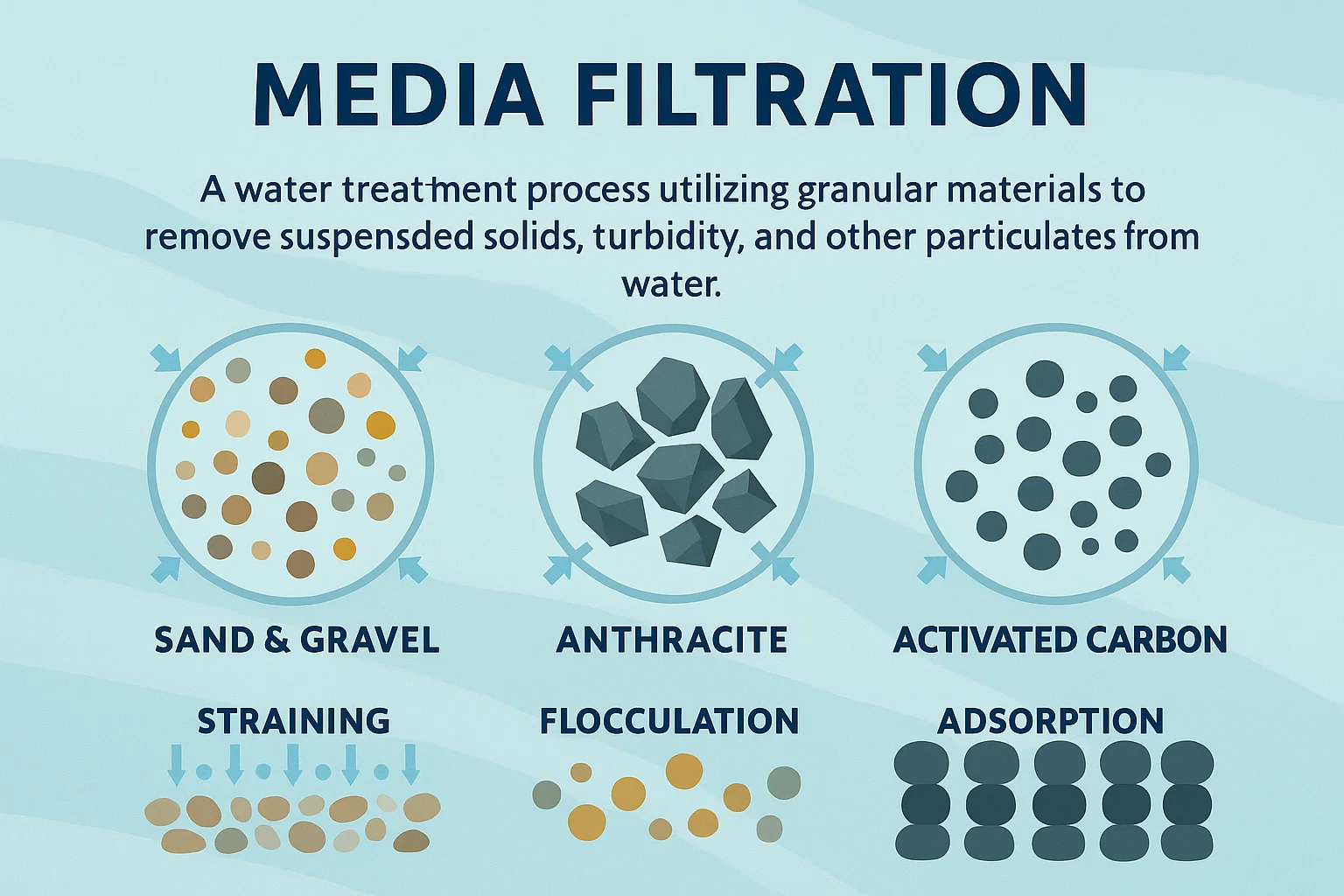 +86-15267462807
+86-15267462807
Access to clean, safe water is a fundamental global challenge, and effective water treatment is the cornerstone of public health, environmental protection, and industrial processes. The quality of water can vary greatly depending on its source, from rivers and lakes to municipal supplies and industrial effluent. To make this water usable for drinking, manufacturing, or agriculture, it must be treated to remove impurities. Two of the most common and critical technologies used to achieve this are media filtration and membrane filtration.
While both methods are designed to separate contaminants from water, they operate on different principles and are suited for different applications. This article will provide a comprehensive comparison of media and membrane filtration, exploring their respective processes, applications, advantages, and disadvantages to help you choose the right solution for your specific water treatment needs.

Media filtration is a water treatment process that utilizes a bed of granular materials—the filter media—to remove suspended solids, turbidity, and other impurities from water. This is a form of depth filtration, where particles are captured not just on the surface but throughout the entire depth of the filter bed.

The media used in these filters are chosen based on the specific contaminants to be removed and the desired water quality. Common types of media include:
Sand and Gravel: This is the most traditional and widely used media. Water flows through a bed of fine sand, which traps suspended solids. A layer of coarser gravel at the bottom supports the sand and helps with drainage.
Anthracite: A low-density coal, anthracite is often used in combination with sand in multi-media filters. Its larger, more angular particles trap larger solids and prevent the top layer from becoming clogged too quickly, allowing for deeper penetration and longer run times.
Activated Carbon: This highly porous material is a special type of media used for its ability to adsorb contaminants. It excels at removing organic compounds, chlorine, pesticides, and other chemicals that cause bad taste and odor.
The filtration process works by passing water through the media bed, either by gravity or under pressure. As water moves through the filter, contaminants are removed through several mechanisms:
Straining: Larger particles are physically strained out by the small gaps between the media grains.
Adsorption: Particles stick to the surface of the media, a process called adsorption. This is particularly effective for activated carbon.
Flocculation: Fine particles collide and stick together as they move through the filter, forming larger particles that are then more easily trapped.
Over time, the trapped solids build up in the media bed, causing an increase in pressure and a decrease in flow. When this happens, the filter must be backwashed, a process where the water flow is reversed to dislodge the trapped particles and flush them out, cleaning the media bed and restoring its filtering capacity.
Media filtration is a robust and versatile technology, primarily used for pre-treatment and initial water clarification. Its applications include:
Pre-treatment for other filtration methods: It is commonly used as a first step to remove large particles and protect more sensitive downstream equipment, such as reverse osmosis membranes, from fouling.
Wastewater treatment: It is used to polish effluent from wastewater treatment plants to remove remaining suspended solids before discharge.
Drinking water treatment: Media filters are essential for removing sediment, turbidity, and suspended solids from source water, making it clearer and safer for further purification steps.
Industrial processes: It's used in cooling towers, irrigation, and other industrial applications where the primary goal is to reduce suspended solids and prevent equipment damage.
Membrane filtration is a water treatment technology that uses a semi-permeable membrane to separate contaminants from water based on their physical size and characteristics. Unlike media filtration, which relies on the depth of the filter bed, membrane filtration is a surface filtration process, where particles are rejected at the membrane's surface. This is a pressure-driven process, meaning water is forced through the membrane, leaving impurities behind.

Membrane filtration is categorized by the size of the pores in the membrane, which determines the type of contaminants it can remove. The main types, in order of decreasing pore size, are:
Microfiltration (MF): Uses membranes with a pore size of approximately 0.1 to 10 microns. MF effectively removes suspended solids, colloids, and large microorganisms like bacteria and protozoa, but it cannot remove viruses or dissolved substances.
Ultrafiltration (UF): Has smaller pores, typically from 0.01 to 0.1 microns. UF is a significant step up, capable of removing all of the contaminants that MF can, plus viruses, some proteins, and other large organic molecules.
Nanofiltration (NF): Operates with a pore size around 0.001 microns. NF is often called a "softening membrane" because it can remove hardness-causing ions like calcium and magnesium, as well as viruses and most organic molecules.
Reverse Osmosis (RO): This is the most advanced form of membrane filtration, with a pore size of about 0.0001 microns. RO can remove virtually all contaminants, including dissolved salts, heavy metals, and viruses, producing highly purified water.
The core principle behind membrane filtration is size exclusion. Water is pushed through the membrane under high pressure, while contaminants that are larger than the membrane's pores are physically blocked and "rejected" by the membrane's surface. The rejected stream, known as the concentrate or brine, contains the impurities, while the purified water, called the permeate, passes through.
A major challenge for membrane systems is fouling, where contaminants build up on the membrane surface, reducing its efficiency and flow rate. This necessitates regular cleaning or replacement of the membranes. To mitigate fouling, membrane systems often require effective pre-treatment, which is where media filtration is often used.
Due to their ability to remove extremely small particles and dissolved substances, membrane filters are used in applications that demand very high water purity. Their applications include:
Drinking water purification: UF and RO are widely used to produce safe drinking water, removing harmful bacteria, viruses, and a wide range of dissolved solids.
Industrial process water: Industries like electronics manufacturing and power generation require ultra-pure water to prevent damage to sensitive equipment.
Pharmaceuticals: The pharmaceutical industry uses membrane filtration to produce water of the highest purity for drug formulation and sterile processes.
Seawater desalination: RO is the key technology used to convert saltwater into fresh, drinkable water on a large scale.
| Feature | Media Filtration | Membrane Filtration |
| Pore Size & Filtration Capability | Larger pores (10+ microns). Removes suspended solids, turbidity, and large particles. Cannot remove bacteria, viruses, or dissolved substances. | Much smaller pores (down to 0.0001 microns). Removes bacteria, viruses, dissolved solids, and organic molecules. |
| Operating Pressure | Low pressure (gravity or low pump pressure). | High pressure (requires powerful pumps). |
| Water Quality Achieved | Produces clear water with reduced turbidity. Often used for pre-treatment. | Produces high-purity water, often clean enough for drinking or industrial use without further treatment. |
| Cost | Lower initial and operational costs. | Higher initial and operational costs due to more complex equipment and energy requirements. |
| Maintenance | Requires periodic backwashing to clean the media bed. Media may need to be replaced every few years. | Prone to fouling, requiring chemical cleaning or membrane replacement. Pre-treatment is crucial to minimize maintenance. |
Advantages:
Cost-effective: It's a low-cost solution for treating large volumes of water with high levels of suspended solids.
High Flow Rates: Can handle high flow rates, making it suitable for pre-treatment and large-scale applications.
Simplicity: The process is relatively simple to operate and maintain.
Disadvantages:
Limited Removal: Not effective for removing small contaminants like bacteria, viruses, or dissolved minerals.
Potential for Clogging: Can become clogged quickly without proper pre-treatment, especially with high-turbidity water.
Advantages:
High Purity Water: Produces water of exceptional purity, removing a wide range of contaminants, including pathogens and dissolved solids.
Physical Barrier: The membrane acts as a physical barrier, ensuring consistent contaminant removal.
Disadvantages:
Higher Cost: Significant initial investment and ongoing operational costs due to energy consumption and membrane replacement.
Requires Pre-treatment: Highly susceptible to fouling, which necessitates effective pre-treatment to protect the membranes and extend their lifespan.
Water Waste: In processes like reverse osmosis, a significant amount of water is sent to the drain as a concentrate stream.
The choice between media and membrane filtration ultimately depends on the desired water quality and the characteristics of the source water.
High turbidity water: It's the ideal choice for treating water with a high concentration of suspended solids, such as river water or wastewater.
Pre-treatment for membrane filtration: It's a critical first step to protect sensitive membrane systems from fouling.
Applications not requiring high purity: Use when the goal is to remove sediment and large particles for industrial cooling, irrigation, or as a primary clarification step.
High purity water is required: When the end use demands water with minimal dissolved solids, bacteria, or viruses, such as in drinking water, pharmaceutical production, or electronics manufacturing.
Removal of specific contaminants: Used when the primary goal is to remove specific pathogens, salts, or other dissolved substances that media filters cannot handle.
Water reuse and desalination: Essential for large-scale water reuse projects and converting saltwater to freshwater.
Filtration technologies are constantly evolving, with a focus on improving efficiency, reducing costs, and making systems more sustainable. Here are some notable recent advances:
Hybrid Systems: One of the most significant trends is the development of hybrid systems that combine the best aspects of both media and membrane filtration. A common setup involves using media filtration as a robust pre-treatment step to remove a majority of the suspended solids, thereby extending the lifespan and reducing the cleaning frequency of the more sensitive and expensive membranes. This not only improves the overall system's efficiency but also lowers operational costs.
Novel Media and Membranes: Researchers are developing new, advanced filter media and membranes with enhanced properties. For example, some media are now being embedded with nanoparticles (e.g., silver or titanium dioxide) to provide antibacterial properties, while next-generation membranes are being engineered to be more resilient to fouling and to require less pressure to operate, reducing energy consumption.
Sensor and Automation Technology: Modern filtration systems are increasingly integrated with real-time sensors and automated controls. These systems can monitor water quality, flow rates, and pressure differentials to automatically initiate backwashing or chemical cleaning cycles. This smart automation optimizes performance, reduces manual intervention, and prevents system failure.
Choosing between media and membrane filtration is not about one being inherently "better" than the other; rather, it's about selecting the right tool for the job.
Media filtration is the workhorse of water treatment, serving as a reliable and cost-effective solution for removing large particles and turbidity. It is an essential first step for most complex water treatment processes.
Membrane filtration is the precision instrument, capable of delivering a level of purity that media filters cannot match. It is the go-to technology when removing microscopic contaminants, pathogens, and dissolved substances is critical.